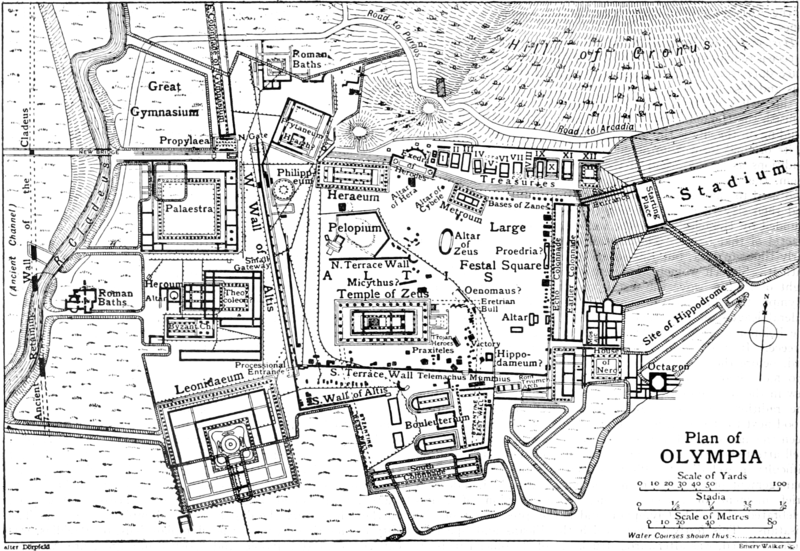The Olympian temple of Zeus is said to have been dismantled, either by the Goths or by Christian zeal, in the reign of Theodosius II. (A.D. 402–450). After this the inhabitants converted the temple of Zeus and the region to the south of it into a fortress, by constructing a wall from materials found among the ancient buildings. The temple was probably thrown down by earthquakes in the 6th century A.D.
Excavations.—The German excavations were begun in 1875. After six campaigns, of which the first five lasted from September to June, they were completed on the 20th of March 1881. The result of these six years’ labours was, first, to strip off a thick covering of earth from the Altis, the consecrated precinct of the Olympian Zeus. This covering had been formed, during some twelve centuries, partly by clay swept down from the Cronion, partly by deposit from the overflowings of the Cladeus. The coating of earth over the Altis had an average depth of no less than 16 ft.
The work could not, however, be restricted to the Altis. It was necessary to dig beyond it, especially on the west, the south and the east, where several ancient buildings existed, not included within the sacred precinct itself. The complexity of the task was further increased by the fact that in many places early Greek work had later Greek on top of it, or late Greek work had been overlaid with Roman. In a concise survey of the results obtained, it will be best to begin with the remains external to the precinct of Zeus.
I. Remains outside the Altis
A. West Side.—The wall bounding the Altis on the west belongs probably to the time of Nero. In the west wall were two gates, one at its northern and the other at its southern extremity. The latter must have served as the processional entrance. Each gate was πρόστυλος, having before it on the west a colonnade consisting of a row of four columns. There is a third and smaller gate at about the middle point of the west wall, and nearly opposite the Pelopion in the Altis.
West of the west Altis wall, on the strip of ground between the Altis and the river Cladeus (of which the course is roughly parallel to the west Altis wall), the following buildings were traced. The order in which they are placed here is that in which they succeed each other from north to south.
1. Just outside the Altis at its north-west corner was a Gymnasium. A large open space, not regularly rectangular, was enclosed on two sides—possibly on three—by Doric colonnades. On the south it was bordered by a portico with a single row of columns in front; on the east by a double portico, more than a stadium in length (220 yds.), and serving as a racecourse for practice in bad weather. At the south-east corner of the gymnasium, in the angle between the south and the east portico, was a Corinthian doorway, which a double row of columns divided into three passages. Immediately to the east of this doorway was the gate giving access to the Altis at its north-west corner. The gymnasium was used as an exercise ground for competitors during the last month of their training.
2. Immediately adjoining the gymnasium on the south was a Palaestra, the place of exercise for wrestlers and boxers. It was in the form of a square, of which each side was about 70 yds. long, enclosing an inner building surrounded by a Doric colonnade. Facing this inner building on north, east and west were rooms of different sizes, to which doors or colonnades gave access. The chief entrances to the palaestra were at south-west and south-east, separated by a double colonnade which extended along the south side.
3. Near the palaestra on the south a Byzantine church forms the central point in a complex group of remains, (a) The church itself occupies the site of an older brick building, which is perhaps a remnant of the “workshop of Pheidias” seen by Pausanias. (b) North of the church is a square court with a well in the middle, of the Hellenic age. (c) West of this is a small circular structure, enclosed by square walls. An altar found (in situ) on the south side of the circular enclosure shows by an inscription that this was the Heroum, where worship of the heroes was practised down to a late period, (d) East of the court stood a large building, of Roman age at latest, arranged round an inner hall with colonnades. These buildings probably formed the Theocoleon, house of the priests. (e) There is also a long and narrow building on the south of the, Byzantine church. This may have been occupied by the φαιδρύνται, those alleged “descendants of Pheidias” (Pausanias v. 14) whose hereditary privilege it was to keep the statue of Zeus clean. The so-called “workshop of Pheidias” (see a) evidently owed its preservation to the fact that it continued to be used for actual work,

